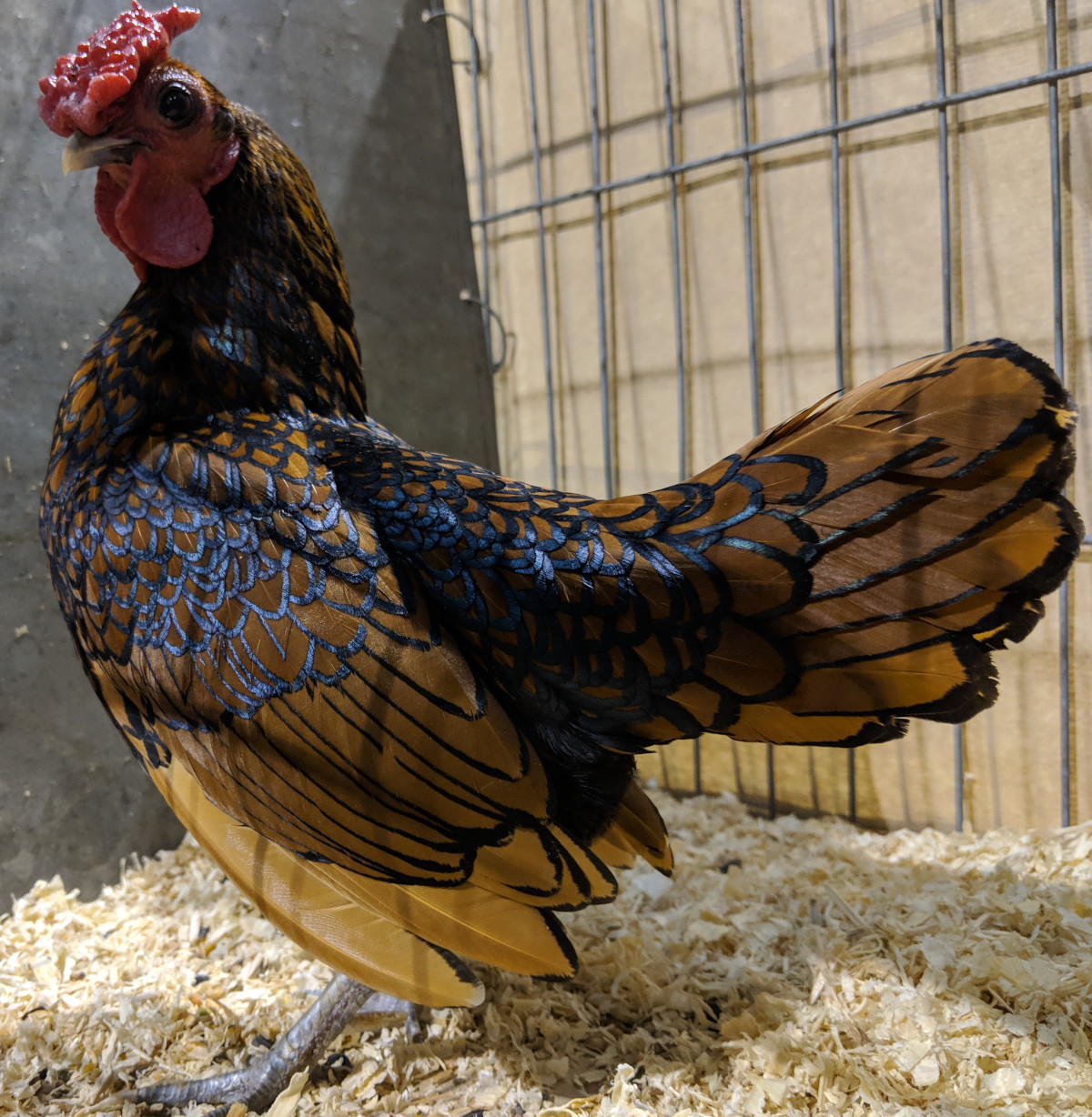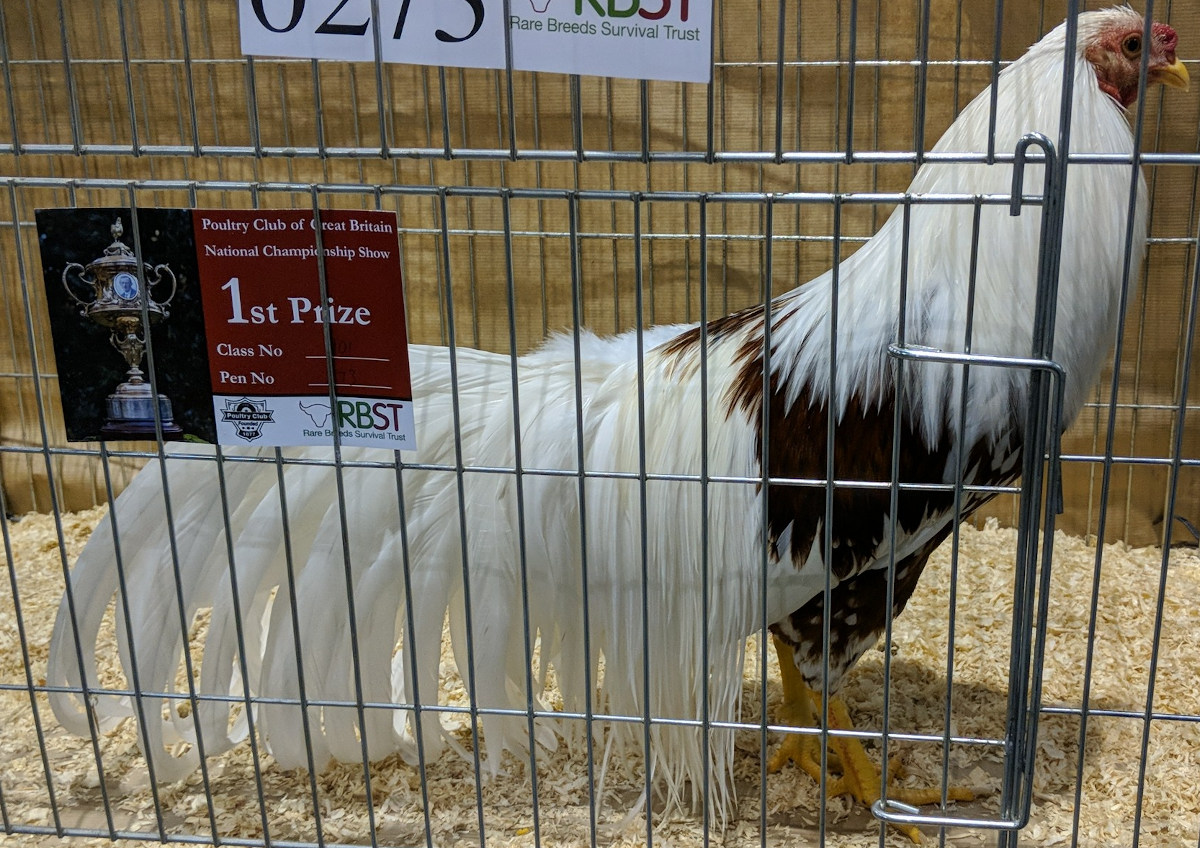
Tips, tricks, secrets and cheats of poultry fanciers.
So if you have ever wondered how some chickens look so perfect in the show cages, it may not be all it seems.
There are plenty of secrets and tricks in the showing arena and not all of them are absolutely fair and honest, or even legal.
Table of Contents
If you modify a bird that is in a show contest in any way by plucking out or dyeing feathers, gluing in extra feathers, or darkening combs with boot polish any a good judge will likely spot an attempt at deception and disqualify the bird.
Let us start with the feet:
The Yellow legs of a fowl can be improved by repeated application of thinned iodine or saffron yellow. Both are excellent stains and when applied thinly in very small amounts repeatedly over a long period will stain the legs of the chicken.
Hiding unwanted leg feathers. Sometimes an otherwise excellent specimen might have a few leg feathers that might prevent the bird from winning. Down feathers do nor normally leave any hole when pulled but larger feather may leave a stub which is easily seen.
The cavity can be filled with beeswax or linseed putty, coloured if necessary and well rubbed in to hide any blemish.
Heads, beaks, combs and wattles:
To brighten the combs, face and wattles of birds in the show room a solution of two parts alcohol and one part glycerine with three drops of oil of sassafras to each teaspoonful of the mixture. From two to four applications on the day before the show will produce results. Use a small sponge or soft cloth and apply just enough each time to moisten the parts, taking great care to not get the mixture into the eyes.
In the old days, lopped combs were prevented by dusting cayenne pepper and / or tobacco dust under the wings of birds to stop them roosting with their head under the wing as it was believed this caused the comb to fold over under the wing.
A small amount of unwanted black, brown or other colour may sometimes be removed from yellow beaks by using fine sand paper or an ordinary finger-nail file. The result depends on the size and depth of the defect and any trimming and filing should be done in tiny amounts over the weeks before the show.
Fixing the feathers in show chickens:
The shape of feathers can be changed or fixed to give better curves if necessary. It only works after the chicken has been washed and the feathers are still damp.
In the process of drying they can be curved and fluffed into shape so the base of the tail fills out. Just like blow drying. In fact the heat from a hair dryer is excellent in moulding feathers. When dry they will hold their shape for a day or two.
Below: Those pristine white feathers and yellow legs may well have been doctored.

Scent free hairspray sprayed carefully on the inside of the feather has been used to hold them in place.
An important matter which never occurs to most when washing their birds is the tendency of the feathers to slightly curl around the edges if placed too close to a source of heat while drying.
Tail feathers can be manipulated for an improvement in shape. Wet feathers can be held in place, with florists wire along their length if necessary, and then dried under heat.
Laundry starch can be used to hold feathers in place. It is applied by soft cloth to slightly damp feathers. It can also help birds stay clean.
Removing the yellow colour, creaminess or brassiness from white chickens feathers: In mild cases laundry blue or wash bluing is used. This is a whitener that is added to most washing detergents and can be purchased separately. You simply add a little to the birds bath water and it does the same thing to the white chicken feathers that it does to your white T shirts in the washing machine.
For more extreme cases Hydrogen peroxide or Oxalic acid have been used. These effectively bleach the colour from the feathers. Bluing and bleach all need to be used with great care and in small amounts. Too much of any of them will be worse than none.
A diet of 10% linseed in the days before and after the washing will help the feathers keep their lustre.
The white tips of barred or coloured feathers can be removed by burning or searing with a hot iron or poker. You must use a hot iron or ember as a flame can not be properly controlled. The singed feather is then rubbed between the thumb and finger to hide the evidence.
Splicing feathers: Wing feathers suffer to much daily stress in use to be repaired by splicing but tail and sickle feather can be put back or replaced by this technique. It is sometimes called tipping in.
The broken feathers is pinched between the thumb and finger and cut off exactly at or just below skin level.
The new feather is pushed in after a little glue as been applied to it's base. I have actually seen this done by a skilled hand and I could not see the difference.
Improving the plumage colour of red birds: Potassium permanganate is a disinfectant used to treat a variety of skin conditions and in low concentrations applied after a wash it stains the feathers readily and enhances the red colour of the fowl. Again it needs to be used in tiny quantities to heighten existing colour rather than bigger amounts to force change.
Remove or lighten the dark streaks in feather quills by rubbing gently with a pumice stone and then with either a little candle wax to cover the rough shaft or very fine chalk powder.
Colour issues on the edges of large or wing feathers can be rubbed away with a pumice stone and the result just looks like the chicken has been wearing its wings on the cage over time.
In black fowl the white feathers or defects in the plumage can be covered by India ink, lamp black or graphite powder. These are essentially soot from oil lamps , ground graphite or a permanent plant based dye.
In the days before the show they can be applied to cover blacken defects and are very difficult to detect.
Graphite powder will also cover the dreaded purple barring sometimes found in the sheen on feathers.
Single off coloured feathers can just be plucked and indeed some feather patterns can be improved by pulling a few feathers.
Broken feathers can be pulled eight weeks before the show to ensure new ones grow in time.
Birds can be artificially moulted by decreasing their day length to 8 hours, changing their feed to an all grain and in some cases actually pulling the feathers to force new ones to grow.
This gives a fowl with new feathers all over in late summer several months before but seems cruel to me.
Show pullets are kept under short days to slow the start of laying keeping them in their prime condition longer. They can also be moved to a new hen house on a weekly basis to hold back the start of laying.
Feeding:
As much as a pound can be added to the weight of an under performing bird with the use of a special diet. The chickens must be kept confined and fed a diet of boiled rice, cooked potatoes and ground oat porridge made with condensed milk in addition to normal feed as well as being given sweetened water.
The stance of show birds can be improved by feeding them up high in the cage so they get used to being more upright.
Nobbling other competitors:
One very old hand passed this gem on to me, and he did say he had never used it but did think he had been the victim.
This is a way of doctoring a competitors chicken by putting a sprinkling of clear spirits or whiskey soaked grain in the show cage an hour or so before the judging.
The result is a half cut chicken that droops it's head and tail and looks listless.
